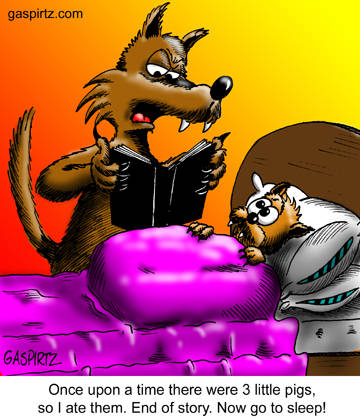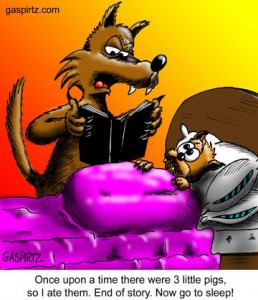In popular culture, especially literary references, wolves are usually sly, cunning and vicious. Think of the fairy tale wolf villain who used his drag queen and voice modulation skills to fool Little Red Riding Hood into thinking that he was her aged grandmother. Some literary wolves are more than a little bit gullible; thwarted in his attempts to demolish a house of brick, the Big Bad Wolf resorted to a chimney entrance route to reach his porcine prey. Not the wisest option; he should have known that the Three Little Pigs had plenty of straw and sticks to kindle a substantial fire.
Captive wolves can be just as cunning as their fairy tale counterparts. RTE’s series on Dublin Zoo featured amazing footage of an extensive tunnel system the wolves had excavated below their exhibit. They were slowly making headway towards the boundary fence and would have eventually escaped into the Phoenix Park had their attempts not been thwarted by vigilant keepers. Surely these wolves’ valiant efforts deserves a theme tune…
Anthropomorphic representations of wolves are undoubtedly influenced by their status as carnivores. It’s easy to project evil characteristics or motivations onto animals that hunt and kill cute and placid grass-munchers. In contrast, can you think of any stories about evil or menacing herbivores? (What exactly is an evil giraffe?)
Interestingly, though, our literary biases against carnivores only extend to some species. Think of all the children’s books about cute and cuddly polar bears; somehow they manage to gloss over the blood and gore at the end of this incredible video.
Cultural biases and anthropomorphic labelling of wolves as “evil” or “cruel” may even contribute to some of the staunch opposition to wolf reintroduction and management programs. Wolves are sometimes perceived as vicious killers with no role in or value to an ecosystem. This is in contrast to other sympatric predators, such as cougars, which can be equal if not greater threats to both humans and livestock but don’t elicit the same controversies or opposition to their management or conservation. The difference in our perceptions of these predators seems to be historical. It’s much easier for ranchers to accept and cope with the threats from cougars than to contemplate or deal with the problems associated with reintroducing wolves back into areas which formed part of their historical range.
I’m not attempting to dismiss or belittle the very legitimate concerns and problems associated with managing and protecting wolves. But perhaps if we change how we perceive and depict wolves in our stories and culture it would help to rejuvenate their image and re-cast them as no more evil or menacing than other predators with which we have learned to cope.
I think we need to boost wolves’ PR. The Twilight series is certainly playing its role in this mission; wolves have never been so popular among teenage girls. Despite these efforts, we need more positive cultural and literary links to wolves. Perhaps a new series of children’s books about “Winston the wistful wolf” or an uplifting Disney wolf cub coming-of-age story would do the trick? These majestic creatures should not suffer the fate of perpetual villain type-casting.
Author
Sive Finlay: sfinlay[at]tcd.ie
Photo credit
Wikimedia commons



One Reply to “Who’s afraid of the big bad wolf?”